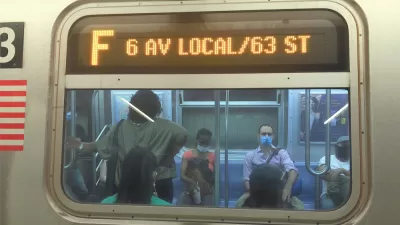As the U.S. House of representatives approved the passive stimulus package approved by the U.S. Senate earlier in the week, more details emerged about the parts of the bill that will be relevant to planners during the coming weeks and months.
Planetizen coverage of the federal stimulus package focused on initial reports about funding for public transit and housing relief shortly included in the package approved by the Senate on March 25.
With the House of Representatives approving the package on Friday, more details are available about the portions of the package that will be relevant to the efforts of planners to provide relief during the economic and public health crises of the coronavirus pandemic.
On March 26, the Planners' Advocacy Network of the American Planning Association (APA Advocates) hosted a virtual discussion to react to the stimulus bill, which you watch above. On March 27, APA Advocates posted a Twitter thread with specific information about the provisions included in the stimulus package.
The U.S. House of Representatives is preparing to vote on the CARES Act, which will provide communities with immediate #Coronavirus relief. Here's everything planners need to know. #CARESact
thread below (1/16)— APAadvocates (@APAadvocates) March 27, 2020
On March 25, the International Economic Development posted a pdf that lists the specific provisions in the bill designed to support the economy and ease the burden of the pandemic for families and workers.
For a higher level perspective on the bill, see also analysis by Kelsey Snell, for NPR, which breaks down the bill's spending by group: 1) 560 billion for individuals, $500 billion for big corporations, $377 billion for small businesses, $339.8 billion for state and local governments, $153.5 billion for public health, $43.7 billion for education/other, and $26 billion for the safety net.
The approved bill will be known as the CARES Act, short for the the Coronavirus Aid, Relief, and Economic Security Act.
FULL STORY: What's Inside The Senate's $2 Trillion Coronavirus Aid Package

Alabama: Trump Terminates Settlements for Black Communities Harmed By Raw Sewage
Trump deemed the landmark civil rights agreement “illegal DEI and environmental justice policy.”

Study: Maui’s Plan to Convert Vacation Rentals to Long-Term Housing Could Cause Nearly $1 Billion Economic Loss
The plan would reduce visitor accommodation by 25% resulting in 1,900 jobs lost.

Planetizen Federal Action Tracker
A weekly monitor of how Trump’s orders and actions are impacting planners and planning in America.

This Toronto Suburb Has More Bus Riders Than Columbus, Ohio
Brampton, Ontario used gradual improvements in service to prove that if you build it, they will ride.

Paris Bike Boom Leads to Steep Drop in Air Pollution
The French city’s air quality has improved dramatically in the past 20 years, coinciding with a growth in cycling.

Why Housing Costs More to Build in California Than in Texas
Hard costs like labor and materials combined with ‘soft’ costs such as permitting make building in the San Francisco Bay Area almost three times as costly as in Texas cities.
Urban Design for Planners 1: Software Tools
This six-course series explores essential urban design concepts using open source software and equips planners with the tools they need to participate fully in the urban design process.
Planning for Universal Design
Learn the tools for implementing Universal Design in planning regulations.
Smith Gee Studio
Alamo Area Metropolitan Planning Organization
City of Santa Clarita
Institute for Housing and Urban Development Studies (IHS)
City of Grandview
Harvard GSD Executive Education
Toledo-Lucas County Plan Commissions
Salt Lake City
NYU Wagner Graduate School of Public Service





























